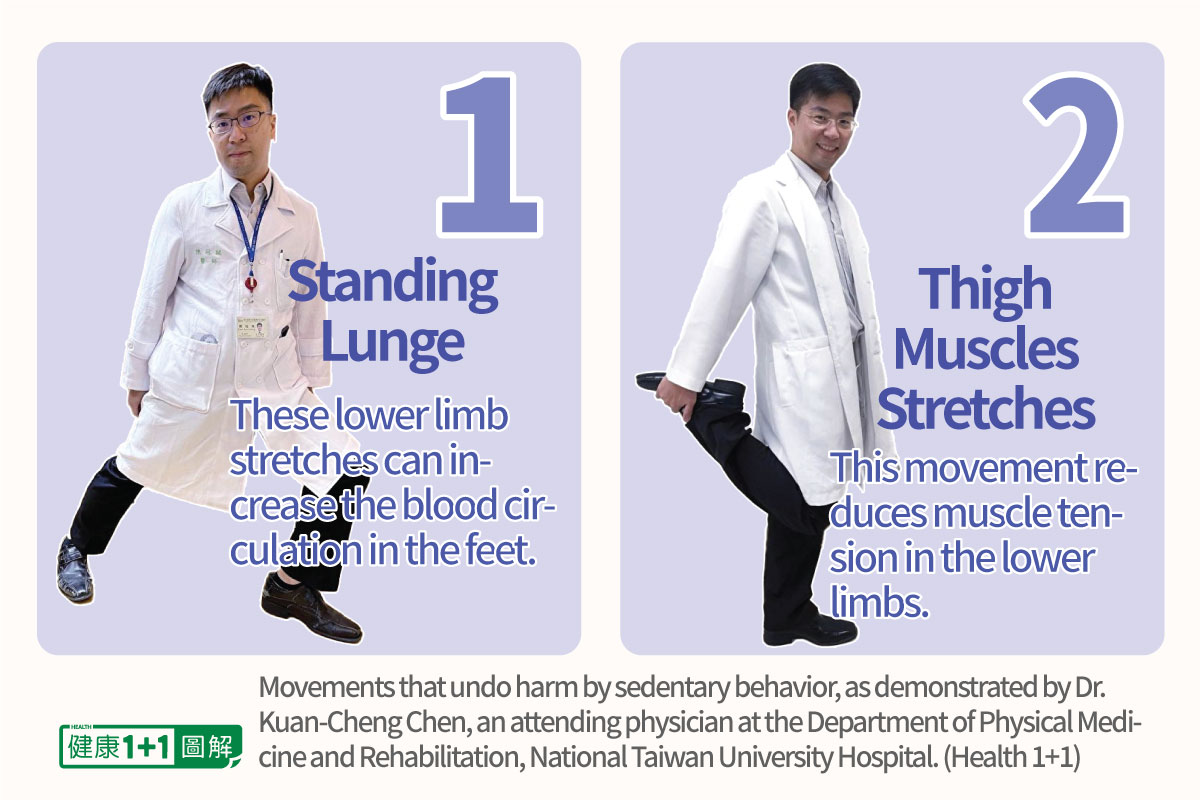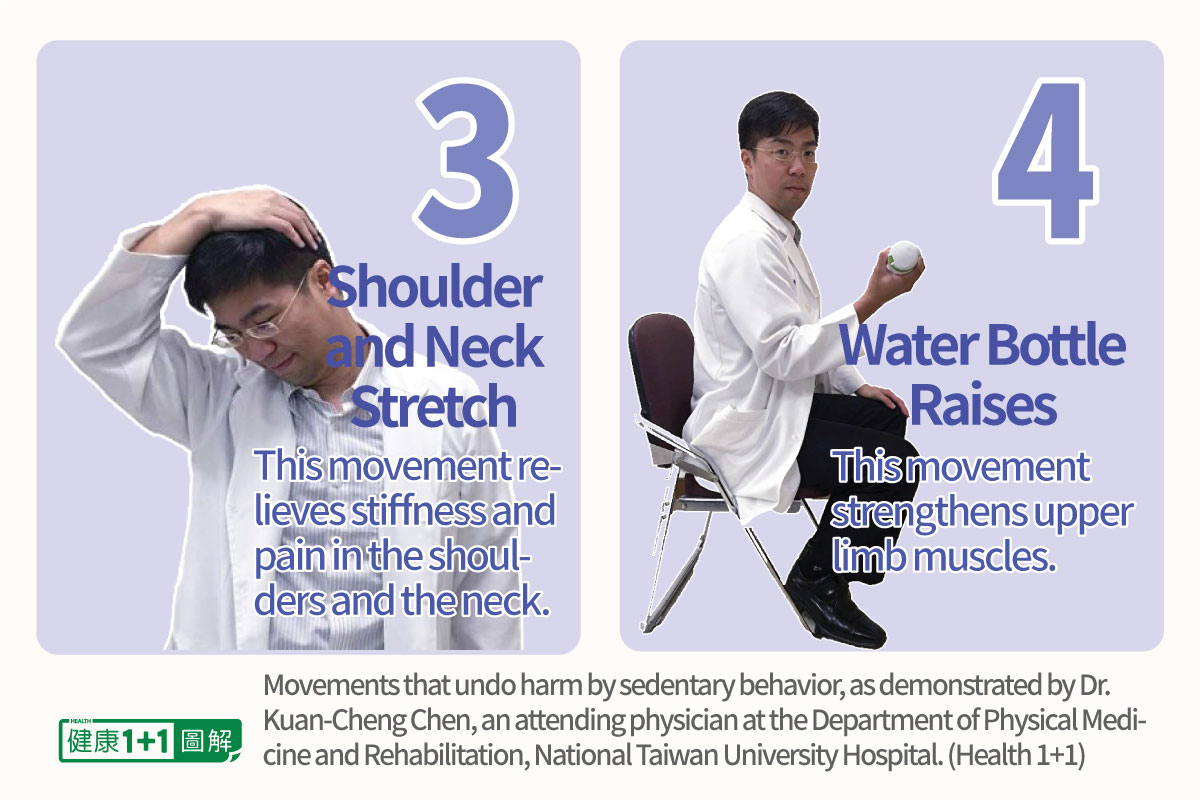6 Movements to Help You Undo Harm Done by Sedentary Behavior
Sedentary behavior may impact people’s life expectancy in negative ways. Many studies have found that sedentary behavior increases the incidence of fatal diseases. In addition to reducing sitting time, there are six movements to stretch the stiff body, strengthen muscle strength, and reduce the damage done by sedentary behavior.Sedentary behavior increases the risk of death, which cannot be completely offset by regular exercises. Whether it’s occupational prolonged sitting, physical inaction due to playing video games, or watching TV shows, people are spending more time sitting, which is causing more health issues. According to a study published in the Journal of the National Cancer Institute (JNCI), the long sitting times have been linked with the risk of certain cancers, diabetes, and cardiovascular disease. A sedentary lifestyle will likely lead to poor circulation and thickening of the blood, resulting in high blood pressure and arteriosclerosis over time. Blood stagnation may occur in the lower extremities, which may lead to thrombosis. Continuous sedentary behavior will also increase the resistance of body cells to insulin, leading to diabetes. Many studies on the harm of sedentary behavior have highlighted that sedentary behavior is undoubtedly similar to “chronic suicide.” Dr. Kuan-Cheng Chen, an attending physician at the Department of Physical Medicine and Rehabilitation, National Taiwan University Hospital, said that sedentary behavior involves multiple organs and systems in the body and that the mechanism is very complex. People who sit for long hours will likely see reduced calorie consumption and metabolic decline, resulting in obesity or metabolic syndrome. Sedentary behavior will also cause bone loss, loss of muscle strength, and in severe cases, sarcopenia, according to Dr. Chen. Worse still, even regular weekly exercises cannot completely offset the negative effects of sedentary behavior. A study by the University of Toronto found that, compared to people who sit less, sedentary people have a 90 percent higher risk of developing diabetes, an 18 percent higher risk of dying from heart disease or cancer, and a 24 percent higher risk of dying from any cause. The study points out that these figures are the average between people who have regular exercise habits and those who do not exercise. Dr. David Alter, a cardiologist at the University of Toronto, believes that sitting times and sedentary behavior have important impacts on health, irrespective of physical activity levels. His suggestion to reverse the trend is very simple: “Move more, and sit less.” 6 Simple Movements to Improve Muscle Strength and Relieve Pain Although exercises cannot offset the negative effects of a sedentary lifestyle totally, they can improve the metabolic decline that comes with prolonged sitting. Dr. Chen said that the best way is to reduce prolonged sitting as much as possible while exercising regularly. Dr. Chen suggests that office workers can adopt the method of alternating between standing and sitting—standing to work when appropriate. “If you need to discuss work with colleagues, you can walk to your colleague instead of using communication software. During the work hours, you can get up to go to the toilet, get some drinks, or even simply do a stretching exercise,” Dr. Chen said. He suggests some exercises at least every hour; if possible, it is best to get up from the chair every half hour and move. There are six simple movements that can be done at the desk. Standing lunge (stretching exercise) Steps: Stand straight, step forward with one foot, bend the front knee and straighten the back leg in a bow and arrow stance. Maintain the posture for 10 to 30 seconds, then alternate between the two legs. This lower limb stretching action can increase the blood circulation in the feet. Straightening the back leg can help stretch the ankle and the plantar fascia. Stretching thigh muscles Steps: Gently pull the foot toward the buttocks and keep the heel to the buttocks as close as possible. Keep this posture for 10 to 30 seconds and then switch feet, alternating 4 to 8 times. The stretching of the thigh muscles can avoid pain caused by excessive muscle tension in the lower limbs. Shoulder and neck stretch Step: Tilt your head to your shoulder, and you may use your hand to pull your head slowly further into the stretch until your head is at a 45-degree angle to your shoulder. You can start with either side. Keep the posture for 10-30 seconds and then switch sides. This is a small movement that can be done while sitting in the seat, which can slowly stretch the muscles from the neck to the shoulders. Repeating this movement several times can relieve stiffness and pain in the neck and shoulders. Water bottle workout (strength exercise) Steps: Get two filled water bottles. Hold a bottle forward with one hand (any hand first will do) or bend your elbow to strengthen your

Sedentary behavior may impact people’s life expectancy in negative ways. Many studies have found that sedentary behavior increases the incidence of fatal diseases. In addition to reducing sitting time, there are six movements to stretch the stiff body, strengthen muscle strength, and reduce the damage done by sedentary behavior.
Sedentary behavior increases the risk of death, which cannot be completely offset by regular exercises.
Whether it’s occupational prolonged sitting, physical inaction due to playing video games, or watching TV shows, people are spending more time sitting, which is causing more health issues.
According to a study published in the Journal of the National Cancer Institute (JNCI), the long sitting times have been linked with the risk of certain cancers, diabetes, and cardiovascular disease. A sedentary lifestyle will likely lead to poor circulation and thickening of the blood, resulting in high blood pressure and arteriosclerosis over time. Blood stagnation may occur in the lower extremities, which may lead to thrombosis. Continuous sedentary behavior will also increase the resistance of body cells to insulin, leading to diabetes.
Many studies on the harm of sedentary behavior have highlighted that sedentary behavior is undoubtedly similar to “chronic suicide.”
Dr. Kuan-Cheng Chen, an attending physician at the Department of Physical Medicine and Rehabilitation, National Taiwan University Hospital, said that sedentary behavior involves multiple organs and systems in the body and that the mechanism is very complex. People who sit for long hours will likely see reduced calorie consumption and metabolic decline, resulting in obesity or metabolic syndrome. Sedentary behavior will also cause bone loss, loss of muscle strength, and in severe cases, sarcopenia, according to Dr. Chen.
Worse still, even regular weekly exercises cannot completely offset the negative effects of sedentary behavior.
A study by the University of Toronto found that, compared to people who sit less, sedentary people have a 90 percent higher risk of developing diabetes, an 18 percent higher risk of dying from heart disease or cancer, and a 24 percent higher risk of dying from any cause. The study points out that these figures are the average between people who have regular exercise habits and those who do not exercise.
Dr. David Alter, a cardiologist at the University of Toronto, believes that sitting times and sedentary behavior have important impacts on health, irrespective of physical activity levels. His suggestion to reverse the trend is very simple: “Move more, and sit less.”
6 Simple Movements to Improve Muscle Strength and Relieve Pain
Although exercises cannot offset the negative effects of a sedentary lifestyle totally, they can improve the metabolic decline that comes with prolonged sitting. Dr. Chen said that the best way is to reduce prolonged sitting as much as possible while exercising regularly.
Dr. Chen suggests that office workers can adopt the method of alternating between standing and sitting—standing to work when appropriate. “If you need to discuss work with colleagues, you can walk to your colleague instead of using communication software. During the work hours, you can get up to go to the toilet, get some drinks, or even simply do a stretching exercise,” Dr. Chen said.
He suggests some exercises at least every hour; if possible, it is best to get up from the chair every half hour and move. There are six simple movements that can be done at the desk.
- Standing lunge (stretching exercise)
Steps: Stand straight, step forward with one foot, bend the front knee and straighten the back leg in a bow and arrow stance. Maintain the posture for 10 to 30 seconds, then alternate between the two legs.
This lower limb stretching action can increase the blood circulation in the feet. Straightening the back leg can help stretch the ankle and the plantar fascia.

- Stretching thigh muscles
Steps: Gently pull the foot toward the buttocks and keep the heel to the buttocks as close as possible. Keep this posture for 10 to 30 seconds and then switch feet, alternating 4 to 8 times.
The stretching of the thigh muscles can avoid pain caused by excessive muscle tension in the lower limbs.
- Shoulder and neck stretch
Step: Tilt your head to your shoulder, and you may use your hand to pull your head slowly further into the stretch until your head is at a 45-degree angle to your shoulder. You can start with either side. Keep the posture for 10-30 seconds and then switch sides.
This is a small movement that can be done while sitting in the seat, which can slowly stretch the muscles from the neck to the shoulders. Repeating this movement several times can relieve stiffness and pain in the neck and shoulders.

- Water bottle workout (strength exercise)
Steps: Get two filled water bottles. Hold a bottle forward with one hand (any hand first will do) or bend your elbow to strengthen your upper body muscles effectively. Do both hands in turn and repeat 8 to 12 times.
Strengthening upper limb muscles can avoid the loss of muscle strength caused by sedentary inactivity.
- Leg lifting (strength exercise)
Steps: Sit on a chair, with one leg and foot straightened ahead to do leg lifts. Slowly move the leg up and down. Each leg lift takes 10 to 30 seconds, alternating both legs 8 to 12 times.
This single-legged leg lift exercise can train the thigh quadriceps, strengthen muscle strength, and further improve metabolism.

- Step-ups (strength exercise)
Steps: Find a step, or a stable box or stool with appropriate height as an auxiliary prop for the step-up exercise. First, put one foot on the step, and then the other foot. Remember to put the whole sole of the foot on the step and to really stand straight and steady to avoid a fall. The step-up exercise can be done for 10 to 20 minutes until you feel panting slightly but are able to speak.
The step-up exercise is an aerobic exercise that can strengthen the lower body muscle groups, train muscle endurance, and can also improve the basal metabolic rate.
For regular physical exercises, you need to achieve moderate intensity and exercise for at least 150 minutes per week. By moderate intensity, it means that you feel a little out of breath but are still able to talk. Regular exercises can be brisk walking, jogging, aerobic dance, swimming, bicycling, and so on.
Some people think that doing household chores or physical job assignments means that they have exercised.
“These don’t count,” said Dr. Chen, adding that a study in Copenhagen last year found that labor cannot replace exercise. Exercise has its own value. He suggests that people who often lift heavy objects can choose aerobic exercise to enhance cardiorespiratory function.







